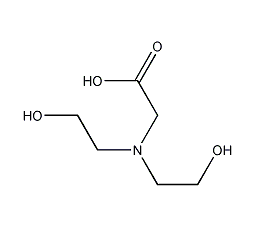
Structural formula
| Business number | 03Y3 |
|---|---|
| Molecular formula | C6H13NO4 |
| Molecular weight | 163.17 |
| label |
N,N-bis(2-hydroxyethyl)glycine, Diethanolglycine, N,N-Bis(2-hydroxyethyl)glycine |
Numbering system
CAS number:150-25-4
MDL number:MFCD00004295
EINECS number:205-755-1
RTECS number:MB9700000
BRN number:1769362
PubChem number:24891738
Physical property data
1. Physical property data:
1. Characteristics: White crystalline powder
2. Density (g/mL,20℃): 1.05
3. Melting point (ºC): 191 ºC
Toxicological data
2. Toxicological data:
1, Acute toxicity: Mouse abdominal cavity LD50: 1540 mg/kg
Ecological data
3. Ecological data:
Usually for Water is not hazardous and materials should not be discharged into the surrounding environment without government permission.
Molecular structure data
5. Molecular property data: 1. Molar refractive index:38.20 2. Molar volume (m3/mol):124.4 3. Isotonic specific volume (90.2K):351.8 4. Surface tension (dyne/cm):63.8 5. Polarizability(10-24cm3):15.14
Compute chemical data
1. Reference value for hydrophobic parameter calculation (XlogP): -3.8
2. Number of hydrogen bond donors: 3
3. Number of hydrogen bond acceptors: 5
4. Number of rotatable chemical bonds: 6
5. Number of tautomers: none
6. Topological molecule polar surface area 81
7. Number of heavy atoms: 11
8. Surface charge: 0
9. Complexity: 111
10. Number of isotope atoms: 0
11. Determine the number of atomic stereocenters: 0
12. Uncertain number of atomic stereocenters: 0
13. Determine the number of chemical bond stereocenters: 0
14. Number of uncertain chemical bond stereocenters: 0
15. Number of covalent bond units: 1
Properties and stability
Stable under normal temperature and pressure.
Storage method
Store at room temperature.
Synthesis method
None
Purpose
Used as a buffering agent in biochemical research.
tyle=”COLOR: #000000″> 3. isotonic specific volume (90.2K):351.8
4. Surface tension (dyne/cm):63.8
5. Polarizability(10-24cm3):15.14
Compute chemical data
1. Reference value for hydrophobic parameter calculation (XlogP): -3.8
2. Number of hydrogen bond donors: 3
3. Number of hydrogen bond acceptors: 5
4. Number of rotatable chemical bonds: 6
5. Number of tautomers: none
6. Topological molecule polar surface area 81
7. Number of heavy atoms: 11
8. Surface charge: 0
9. Complexity: 111
10. Number of isotope atoms: 0
11. Determine the number of atomic stereocenters: 0
12. Uncertain number of atomic stereocenters: 0
13. Determine the number of chemical bond stereocenters: 0
14. Number of uncertain chemical bond stereocenters: 0
15. Number of covalent bond units: 1
Properties and stability
Stable under normal temperature and pressure.
Storage method
Store at room temperature.
Synthesis method
None
Purpose
Used as a buffering agent in biochemical research.

 微信扫一扫打赏
微信扫一扫打赏

